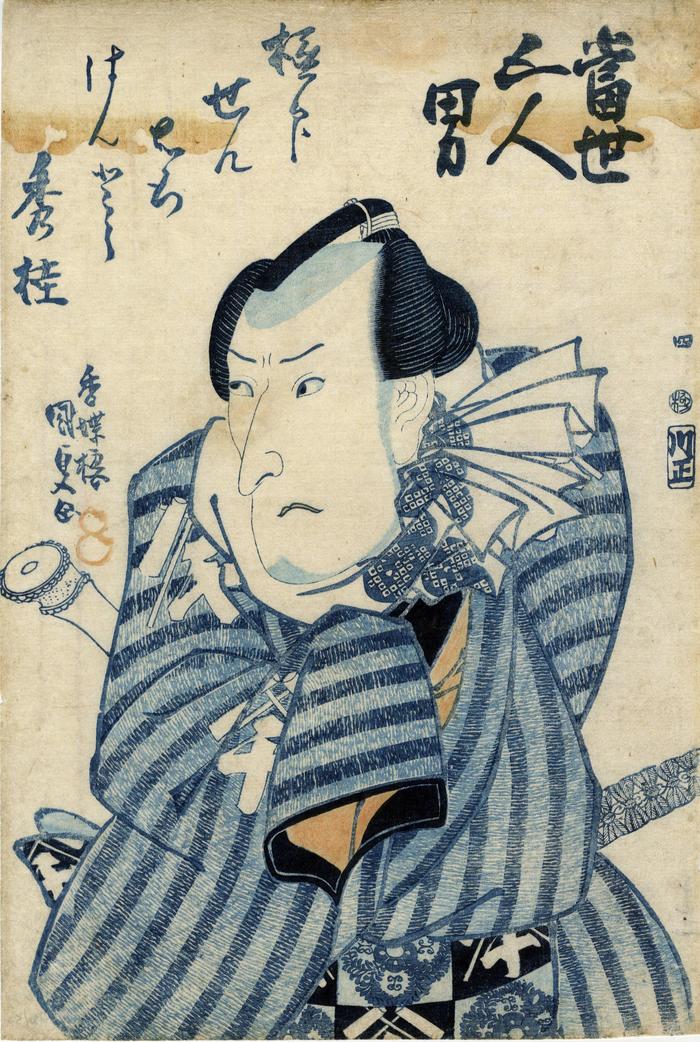Utagawa Kunisada (歌川国貞) / Toyokuni III (三代豊国) (artist 1786 – 01/12/1865)
Bandō Mitsugorō IV (坂東三津五郎) as Gokuin Sen'emon (極印せん右衛門), No. 4 (四) from the series Five Manly Men of the Present Day (Tōsei gonin otoko - 当世五人男)
ca 1835
9.75 in x 14.5 in (Overall dimensions) Japanese color woodblock print
Signed: Kōchōrō Kunisada ga
香蝶楼国貞画
Artist's seal: Double toshidama
Publisher: Kawaguchiya Shōzō
(Marks 231 seal 25-355)
Waseda University
Museum of Fine Arts, Boston - version with large fan cartouche - publisher: Sanoya Kihei
Lyon Collection - another example
Japan Arts Council - full series published by Sanoya Kihei
Hankyu Culture Foundation - 1st edition with fan cartouche
Ashmolean Museum - another print from this series, Kaminari Shōkurō
British Museum - the same print from a variant edition by a different publisher - gift of Dr. Ellis Tinios Originally published 1835 by Sanoya Kihei (Marks 446 seal 25-210) with the series title in the upper right on a fan, this example was (later) issued from the same blocks by Kawaguchiya Shōzō and omits the fan and adds a cloud band with gradation (bokashi).
The five actors and roles portrayed in the series (numbers are printed on the right above the censor and publisher's seals):
- Sawamura Tosshō I (Gennosuke II) as Karigane Bunshichi
- Onoe Kikugorō III as An no Heibe
- Ichikawa Hakuen (Danjūrō VII) as Kaminari Shokorō
- Bando Mitsugorō IV as Gokuin Senkichi (Sen'emon)
- Nakamura Shikan II (Utaemon IV) as Hotei Ichiemon
The example in the Museum of Fine Arts, Boston was published by Sanoya Kihei in 1835.
The inscription reads: 極印せん右エ門 はんとう秀佳
****
The real-life Gokuin Sen'emon ca. 1679-1702)
The real Gokuin Sen'emon was a punk, a thug. "Began career of violent crime in 1697; wounded about ten people over the next five years in Gokō-machi and Obama residential quarters, inside the licensed prostitute quarter, at the approaches to Nagahori Yotsu and Horie Sumiyoshi bridges, etc. Associated with Karigane Bunshichi from at least the Tenth Month of 1699. Arrested on the twenty-second day, Sixth Month, 1701, in connection with the investigation of Seven's Gang. Beheaded on the twenty- sixth day of the Eighth Month, 1702."
Quoted from: Osaka: The Merchants' Capital of Early Modern Japan in an essay by Gary Leupp, 'The Five Men of Naniwa: Gang Violence and Popular Culture in Genroku Osaka', p. 134. (JSV)
****
The otokodate frequently carried shakuhachi> flutes both for playing and to as symbols of their authority because they often used them as weapons. This is true of female otokodate too. (JSV)
Kawaguchiya Shōzō (川口屋正蔵) (publisher)
actor prints (yakusha-e - 役者絵) (genre)
blue prints (aizuri-e - 藍摺絵) (genre)
Bandō Mitsugorō IV (四代目坂東三津五郎: from 3/1832 to 10/1850) (actor)
Otokodate - chivalrous men (男伊達) (genre)
